A Molecular Tetrahedral Cobalt–Seleno-Based Complex as an Efficient Electrocatalyst for Water Splitting
Abstract
1. Introduction
2. Results
3. Materials and Methods
3.1. Synthesis of bis(diselenoimidodiphosphinato) Cobalt(II) Complex [Co{(SePiPr2)2N}2]
3.2. Electrochemical Measurements
3.3. Tafel Plots
3.4. Turnover Frequency (TOF)
3.5. Electrode Preparation
3.6. Electrodeposition of RuO2
4. Conclusions
Author Contributions
Funding
Institutional Review Board Statement
Informed Consent Statement
Data Availability Statement
Acknowledgments
Conflicts of Interest
Sample Availability
References
- Dai, L.; Xue, Y.; Qu, L.; Choi, H.J.; Baek, J.B. Metal-Free Catalysts for Oxygen Reduction Reaction. Chem. Rev. 2015, 115, 4823–4892. [Google Scholar] [CrossRef]
- Cook, T.R.; Dogutan, D.K.; Reece, S.Y.; Surendranath, Y.; Teets, T.S.; Nocera, D.G. Solar energy supply and storage for the legacy and nonlegacy worlds. Chem. Rev. 2010, 110, 6474–6502. [Google Scholar] [CrossRef]
- Lefrou, C.; Fabry, P.; Poignet, J.-C. Electrochemistry; Springer: Berlin/Heidelberg, Germany, 2009; ISBN 9782759804252. [Google Scholar]
- Zhong, H.; Campos-Roldán, C.A.; Zhao, Y.; Zhang, S.; Feng, Y.; Alonso-Vante, N. Recent advances of Cobalt-Based electrocatalysts for oxygen electrode reactions and hydrogen evolution reaction. Catalysts 2018, 8, 559. [Google Scholar] [CrossRef]
- Deng, X.; Tüysüz, H. Cobalt-Oxide-Based materials as water oxidation catalyst: Recent progress and challenges. ACS Catal. 2014, 4, 3701–3714. [Google Scholar] [CrossRef]
- Huang, J.; Chen, J.; Yao, T.; He, J.; Jiang, S.; Sun, Z.; Liu, Q.; Cheng, W.; Hu, F.; Jiang, Y.; et al. CoOOH Nanosheets with High Mass Activity for Water Oxidation. Angew. Chem. 2015, 54, 8722–8727. [Google Scholar] [CrossRef] [PubMed]
- Plaisance, C.P.; Van Santen, R.A. Structure Sensitivity of the Oxygen Evolution Reaction Catalyzed by Cobalt(II,III) Oxide. J. Am. Chem. Soc. 2015, 137, 14660–14672. [Google Scholar] [CrossRef] [PubMed]
- Zhang, C.; Bhoyate, S.; Kahol, P.K.; Siam, K.; Poudel, T.P.; Mishra, S.R.; Perez, F.; Gupta, A.; Gupta, G.; Gupta, R.K. Highly Efficient and Durable Electrocatalyst Based on Nanowires of Cobalt Sulfide for Overall Water Splitting. ChemNanoMat 2018, 4, 1240–1246. [Google Scholar] [CrossRef]
- Wang, J.; Zhong, H.X.; Wang, Z.L.; Meng, F.L.; Zhang, X.B. Integrated Three-Dimensional Carbon Paper/Carbon Tubes/Cobalt-Sulfide Sheets as an Efficient Electrode for Overall Water Splitting. ACS Nano 2016, 10, 2342–2348. [Google Scholar] [CrossRef]
- Akram, R.; Khan, M.D.; Zequine, C.; Zhao, C.; Gupta, R.K.; Akhtar, M.; Akhtar, J.; Malik, M.A.; Revaprasadu, N.; Bhatti, M.H. Cobalt sulfide nanoparticles: Synthesis, water splitting and supercapacitance studies. Mater. Sci. Semicond. Process. 2020, 109, 104925. [Google Scholar] [CrossRef]
- Nisar, L.; Sadaqat, M.; Hassan, A.; Babar, N.U.A.; Shah, A.; Najam-Ul-Haq, M.; Ashiq, M.N.; Ehsan, M.F.; Joya, K.S. Ultrathin CoTe nanoflakes electrode demonstrating low overpotential for overall water splitting. Fuel 2020, 280, 118666. [Google Scholar] [CrossRef]
- Gao, Q.; Huang, C.-Q.; Ju, Y.-M.; Gao, M.-R.; Liu, J.-W.; An, D.; Cui, C.-H.; Zheng, Y.-R.; Li, W.-X.; Yu, S.-H. Phase-Selective Syntheses of Cobalt Telluride Nanofleeces for Efficient Oxygen Evolution Catalysts. Angew. Chem. 2017, 129, 7877–7881. [Google Scholar] [CrossRef]
- Masud, J.; Swesi, A.T.; Liyanage, W.P.R.; Nath, M. Cobalt Selenide Nanostructures: An Efficient Bifunctional Catalyst with High Current Density at Low Coverage. ACS Appl. Mater. Interfaces 2016, 8, 17292–17302. [Google Scholar] [CrossRef]
- Liu, T.; Liu, Q.; Asiri, A.M.; Luo, Y.; Sun, X. An amorphous CoSe film behaves as an active and stable full water-splitting electrocatalyst under strongly alkaline conditions. Chem. Commun. 2015, 51, 16683–16686. [Google Scholar] [CrossRef] [PubMed]
- Li, W.; Gao, X.; Xiong, D.; Wei, F.; Song, W.G.; Xu, J.; Liu, L. Hydrothermal Synthesis of Monolithic Co3Se4 Nanowire Electrodes for Oxygen Evolution and Overall Water Splitting with High Efficiency and Extraordinary Catalytic Stability. Adv. Energy Mater. 2017, 7, 1–7. [Google Scholar] [CrossRef]
- Gao, M.R.; Xu, Y.F.; Jiang, J.; Zheng, Y.R.; Yu, S.H. Water oxidation electrocatalyzed by an efficient Mn3O4/CoSe2 nanocomposite. J. Am. Chem. Soc. 2012, 134, 2930–2933. [Google Scholar] [CrossRef] [PubMed]
- Hussain, N.; Wu, F.; Xu, L.; Qian, Y. Co0.85Se hollow spheres constructed of ultrathin 2D mesoporous nanosheets as a novel Bifunctional-Electrode for supercapacitor and water splitting. Nano Res. 2019, 12, 2941–2946. [Google Scholar] [CrossRef]
- Qin, R.; Hou, J.; Xu, C.; Yang, H.; Zhou, Q.; Chen, Z.; Liu, H. Self-Supporting Co0.85Se nanosheets anchored on Co plate as highly efficient electrocatalyst for hydrogen evolution reaction in both acidic and alkaline media. Nano Res. 2020, 13, 2950–2957. [Google Scholar] [CrossRef]
- Cao, S.; Chen, Y.; Kang, L.; Lin, Z.; Fu, W.F. Enhanced photocatalytic H2-evolution by immobilizing CdS nanocrystals on ultrathin Co0.85Se/RGO-PEI nanosheets. J. Mater. Chem. A 2015, 3, 18711–18717. [Google Scholar] [CrossRef]
- Swesi, A.T.; Masud, J.; Nath, M. Nickel selenide as a High-Efficiency catalyst for oxygen evolution reaction. Energy Environ. Sci. 2016, 9, 1771–1782. [Google Scholar] [CrossRef]
- De Silva, U.; Masud, J.; Zhang, N.; Hong, Y.; Liyanage, W.P.R.; Zaeem, M.A.; Nath, M. Nickel telluride as a bifunctional electrocatalyst for efficient water splitting in alkaline medium. J. Mater. Chem. A 2018, 6, 7608–7622. [Google Scholar] [CrossRef]
- Zhang, G.; Zang, S.; Lan, Z.A.; Huang, C.; Li, G.; Wang, X. Cobalt selenide: A versatile cocatalyst for photocatalytic water oxidation with visible light. J. Mater. Chem. A 2015, 3, 17946–17950. [Google Scholar] [CrossRef]
- Cao, X.; Medvedeva, J.E.; Nath, M. Copper Cobalt Selenide as a High-Efficiency Bifunctional Electrocatalyst for Overall Water Splitting: Combined Experimental and Theoretical Study. ACS Appl. Energy Mater. 2020, 3, 3092–3103. [Google Scholar] [CrossRef]
- Cao, X.; Hong, Y.; Zhang, N.; Chen, Q.; Masud, J.; Zaem, M.A.; Nath, M. Phase exploration and identification of multinary Transition-Metal selenides as High-Efficiency oxygen evolution electrocatalysts through combinatorial electrodeposition. ACS Catal. 2018, 8, 8273–8289. [Google Scholar] [CrossRef]
- Guionneau, P.; Marchivie, M.; Bravic, G.; Létard, J.F.; Chasseau, D. Co(II) molecular complexes as a reference for the spin crossover in Fe(II) analogues. J. Mater. Chem. 2002, 12, 2546–2551. [Google Scholar] [CrossRef]
- Ferentinos, E.; Maganas, D.; Raptopoulou, C.P.; Psycharis, V.; Terzis, A.; Robertson, N.; Kyritsis, P. Conversion of tetrahedral to octahedral structures upon solvent coordination: Studies on the M[(OPPh2)(SePPh2)N]2 (M = Co, Ni) and [Ni{(OPPh2)(EPPh2)N}2(dmf)2] (E = S, Se) complexes. Dalton Trans. 2011, 40, 169–180. [Google Scholar] [CrossRef] [PubMed]
- Maganas, D.; Krzystek, J.; Ferentinos, E.; Whyte, A.M.; Robertson, N.; Psycharis, V.; Terzis, A.; Neese, F.; Kyritsis, P. Investigating magnetostructural correlations in the Pseudo-Octahedral trans-[NiII{(OPPh2)(EPPh2)N}2(sol)2] complexes, E = S, Se; sol = DMF, THF) by magnetometry, HFEPR and ab initio quantum chemistry. Inorg. Chem. 2012, 51, 7218–7231. [Google Scholar] [CrossRef]
- Ferentinos, E.; Raptopoulou, C.P.; Psycharis, V.; Terzis, A.; Krzystek, J.; Kyritsis, P. Magnetostructural correlations in S = 1 trans-[Ni{(OPPh2)(EPPh2)N}2(dmso)2], E = S, Se, and related complexes. Polyhedron 2018, 151, 177–184. [Google Scholar] [CrossRef]
- Ferentinos, E.; Xu, M.; Grigoropoulos, A.; Bratsos, I.; Raptopoulou, C.P.; Psycharis, V.; Jiang, S.-D.; Kyritsis, P. Field-induced slow relaxation of magnetization in the S = 3/2 octahedral complexes trans-[Co{(OPPh2)(EPPh2)N}2(dmf)2], E = S, Se: Effects of Co−Se vs. Co−S. coordination. Inorg. Chem. Front. 2019, 6, 1405–1414. [Google Scholar] [CrossRef]
- Sun, Y.; Bigi, J.P.; Piro, N.A.; Tang, M.L.; Long, J.R.; Chang, C.J. Molecular cobalt pentapyridine catalysts for generating hydrogen from water. J. Am. Chem. Soc. 2011, 133, 9212–9215. [Google Scholar] [CrossRef] [PubMed]
- Shi, H.T.; Li, X.X.; Wu, F.H.; Yu, W.B. Electrocatalytic oxygen evolution with a cobalt complex. Dalton Trans. 2017, 46, 16321–16326. [Google Scholar] [CrossRef] [PubMed]
- Mavros, M.G.; Tsuchimochi, T.; Kowalczyk, T.; McIsaac, A.; Wang, L.P.; Van Voorhis, T. What can density functional theory tell us about artificial catalytic water splitting? Inorg. Chem. 2014, 53, 6386–6397. [Google Scholar] [CrossRef] [PubMed]
- Pushkar, Y.; Moonshiram, D.; Purohit, V.; Yan, L.; Alperovich, I. Spectroscopic analysis of catalytic water oxidation by [RuII(bpy) (tpy)H2O]2+ suggests that RuV = O is not a rate-limiting intermediate. J. Am. Chem. Soc. 2014, 136, 11938–11945. [Google Scholar] [CrossRef] [PubMed]
- Ho, X.L.; Das, S.P.; Ng, L.K.S.; Ng, A.Y.R.; Ganguly, R.; Soo, H.S. Cobalt Complex of a Tetraamido Macrocyclic Ligand as a Precursor for Electrocatalytic Hydrogen Evolution. Organometallics 2019, 38, 1397–1406. [Google Scholar] [CrossRef]
- Wilken, M.; Siewert, I. Electrocatalytic Hydrogen Production with a Molecular Cobalt Complex in Aqueous Solution. ChemElectroChem 2020, 7, 217–221. [Google Scholar] [CrossRef]
- Queyriaux, N.; Sun, D.; Fize, J.; Pécaut, J.; Field, M.J.; Chavarot-Kerlidou, M.; Artero, V. Electrocatalytic Hydrogen Evolution with a Cobalt Complex Bearing Pendant Proton Relays: Acid Strength and Applied Potential Govern Mechanism and Stability. J. Am. Chem. Soc. 2020, 142, 274–282. [Google Scholar] [CrossRef] [PubMed]
- Jiang, H.; Zhang, H.; Kang, Q.; Ma, H.; Tong, Y.; Gao, F.; Lu, Q. Rapid Solvent-Evaporation strategy for Three-Dimensional Cobalt-Based complex hierarchical architectures as catalysts for water oxidation. Sci. Rep. 2019, 9, 1–8. [Google Scholar] [CrossRef] [PubMed]
- Li, G.; Zhang, X.; Zhang, H.; Liao, C.; Jiang, G. Bottom-up MOF-Intermediated synthesis of 3D hierarchical flower-like cobalt-based homobimetallic phophide composed of ultrathin nanosheets for highly efficient oxygen evolution reaction. Appl. Catal. B Environ. 2019, 249, 147–154. [Google Scholar] [CrossRef]
- Gilby, L.M.; Piggott, B. The synthesis and X-ray structure of cobalt(II) complexes of iminobis (phosphinechalcogenides), [Co{N(XPR2)2−X,X′}2] (X = S or Se; R = Ph or Pri ). Polyhedron 1999, 18, 1077. [Google Scholar] [CrossRef]
- Sottini, S.; Poneti, G.; Ciattini, S.; Levesanos, N.; Ferentinos, E.; Krzystek, J.; Sorace, L.; Kyritsis, P. Magnetic anisotropy of tetrahedral CoII Single Ion Magnets: Solid state effects. Inorg. Chem. 2016, 55, 9537–9548. [Google Scholar] [CrossRef]
- Panneerselvam, A.; Nguyen, C.Q.; Waters, J.; Malik, M.A.; O’Brien, P.; Raftery, J.; Helliwell, M. Ligand influence on the formation of P/Se semiconductor materials from Metal-Organic complexes. Dalton Trans. 2008, 33, 4499–4506. [Google Scholar] [CrossRef] [PubMed]
- Levesanos, N.; Robertson, S.D.; Maganas, D.; Raptopoulou, C.P.; Terzis, A.; Kyritsis, P.; Chivers, T. Ni[(EPiPr2)2N]2 complexes: Stereoisomers (E = Se) and square-planar coordination (E = Te). Inorg. Chem. 2008, 47, 2949–2951. [Google Scholar] [CrossRef] [PubMed]
- Jiang, S.D.; Maganas, D.; Levesanos, N.; Ferentinos, E.; Haas, S.; Thirunavukkuarasu, K.; Krzystek, J.; Dressel, M.; Bogani, L.; Neese, F.; et al. Direct observation of very large Zero-Field splitting in a tetrahedral NiIISe4 coordination complex. J. Am. Chem. Soc. 2015, 137, 12923–12928. [Google Scholar] [CrossRef]
- Masud, J.; Ioannou, P.C.; Levesanos, N.; Kyritsis, P.; Nath, M. A Molecular Ni-Complex Containing Tetrahedral Nickel Selenide Core as Highly Efficient Electrocatalyst for Water Oxidation. ChemSusChem 2016, 9, 3128–3132. [Google Scholar] [CrossRef] [PubMed]
- Li, H.; Qian, X.; Zhu, C.; Jiang, X.; Shao, L.; Hou, L. Template synthesis of CoSe2/Co3Se4 nanotubes: Tuning of their crystal structures for photovoltaics and hydrogen evolution in alkaline medium. J. Mater. Chem. A 2017, 5, 4513–4526. [Google Scholar] [CrossRef]
- Campos, C.E.M.; De Lima, J.C.; Grandi, T.A.; Machado, K.D.; Pizani, P.S. Structural studies of cobalt selenides prepared by mechanical alloying. Phys. B Condens. Matter 2002, 324, 409–418. [Google Scholar] [CrossRef]
- Kwak, I.H.; Im, H.S.; Jang, D.M.; Kim, Y.W.; Park, K.; Lim, Y.R.; Cha, E.H.; Park, J. CoSe2 and NiSe2 Nanocrystals as Superior Bifunctional Catalysts for Electrochemical and Photoelectrochemical Water Splitting. ACS Appl. Mater. Interfaces 2016, 8, 5327–5334. [Google Scholar] [CrossRef] [PubMed]
- Yang, J.; Cheng, G.H.; Zeng, J.H.; Yu, S.H.; Liu, X.M.; Qian, Y.T. Shape control and characterization of transition metal diselenides MSe2 (M = Ni, Co, Fe) prepared by a Solvothermal-Reduction process. Chem. Mat. 2001, 13, 848–853. [Google Scholar] [CrossRef]
- Trotochaud, L.; Ranney, J.K.; Williams, K.N.; Boettcher, S.W. Solution-Cast metal oxide thin film electrocatalysts for oxygen evolution. J. Am. Chem. Soc. 2012, 134, 17253–17261. [Google Scholar] [CrossRef]
- Bucci, A.; Mondal, S.S.; Martin-Diaconescu, V.; Shafir, A.; Lloret-Fillol, J. Cobalt Amide Imidate Imidazolate Frameworks as Highly Active Oxygen Evolution Model Materials. ACS Appl. Energy Mater. 2019, 2, 8930–8938. [Google Scholar] [CrossRef] [PubMed]
- González-Flores, D.; Sánchez, I.; Zaharieva, I.; Klingan, K.; Heidkamp, J.; Chernev, P.; Menezes, P.W.; Driess, M.; Dau, H.; Montero, M.L. Heterogeneous water oxidation: Surface activity versus amorphization activation in cobalt phosphate catalysts. Angew. Chem. 2015, 54, 2472–2476. [Google Scholar] [CrossRef]
- Meier, H.G.; Vilche, J.R.; Arvia, A.J. The electrochemical behaviour of cobalt in alkaline solutions Part I. The potentiodynamic response in the potential region of the Co/CoO couple. J. Electroanal. Chem. 1982, 134, 251–272. [Google Scholar] [CrossRef]
- Huang, Z.; Song, J.; Du, Y.; Xi, S.; Dou, S.; Nsamzimana, J.M.V.; Wang, C.; Xu, Z.J.; Wang, X. Chemical and structural origin of lattice oxygen oxidation in Co–Zn oxyhydroxide oxygen evolution electrocatalysts. Nat. Energy 2019, 4, 1–10. [Google Scholar] [CrossRef]
- Fang, T.; Fu, L.Z.; Zhou, L.L.; Zhan, S.Z.; Chen, S. Electrochemical-driven water reduction catalyzed by a water soluble cobalt(III) complex with Schiff base ligand. Electrochim. Acta 2015, 178, 368–373. [Google Scholar] [CrossRef]
- Zhang, M.; Zhang, M.T.; Hou, C.; Ke, Z.F.; Lu, T.B. Homogeneous electrocatalytic water oxidation at neutral pH by a robust macrocyclic nickel(II) complex. Angew. Chem. 2014, 53, 13042–13048. [Google Scholar] [CrossRef] [PubMed]
- Xing, Z.; Liu, Q.; Xing, W.; Asiri, A.M.; Sun, X. Interconnected Co-entrapped, N-Doped carbon nanotube film as active hydrogen evolution cathode over the whole PH range. ChemSusChem 2015, 8, 1850–1855. [Google Scholar] [CrossRef]
- Zou, X.; Huang, X.; Goswami, A.; Silva, R.; Sathe, B.R.; Mikmeková, E.; Asefa, T. Cobalt-Embedded Nitrogen-Rich Carbon Nanotubes Efficiently Catalyze Hydrogen Evolution Reaction at All pH Values. Angew. Chem. 2014, 126, 4461–4465. [Google Scholar] [CrossRef]
- Jin, H.; Wang, J.; Su, D.; Wei, Z.; Pang, Z.; Wang, Y. In situ Cobalt–Cobalt oxide/N-Doped carbon hybrids as superior bifunctional electrocatalysts for hydrogen and oxygen evolution. J. Am. Chem. Soc. 2015, 137, 2688–2694. [Google Scholar] [CrossRef] [PubMed]
- Cupertino, D.; Birdsall, D.J.; Slawin, A.M.Z.; Woollins, J.D. The preparation and coordination chemistry of iPr2P(E)NHP(E′)i Pr2 (E, E′ = Se; E = Se, E′ = S; E = S, E′ = O; E,E′ = O. Inorg. Chim. Acta 1999, 290, 1–7. [Google Scholar] [CrossRef]
- Haiduc, I. Dichalcogenoimidodiphosphinate Ligands. In Comprehensive Coordination Chemistry II: From Biology to Nanotechnology; McCleverty, J.A., Meyer, T.J., Eds.; Fundamentals; Elsevier: Amsterdam, The Netherlands, 2004; Volume 1, pp. 323–347. [Google Scholar]
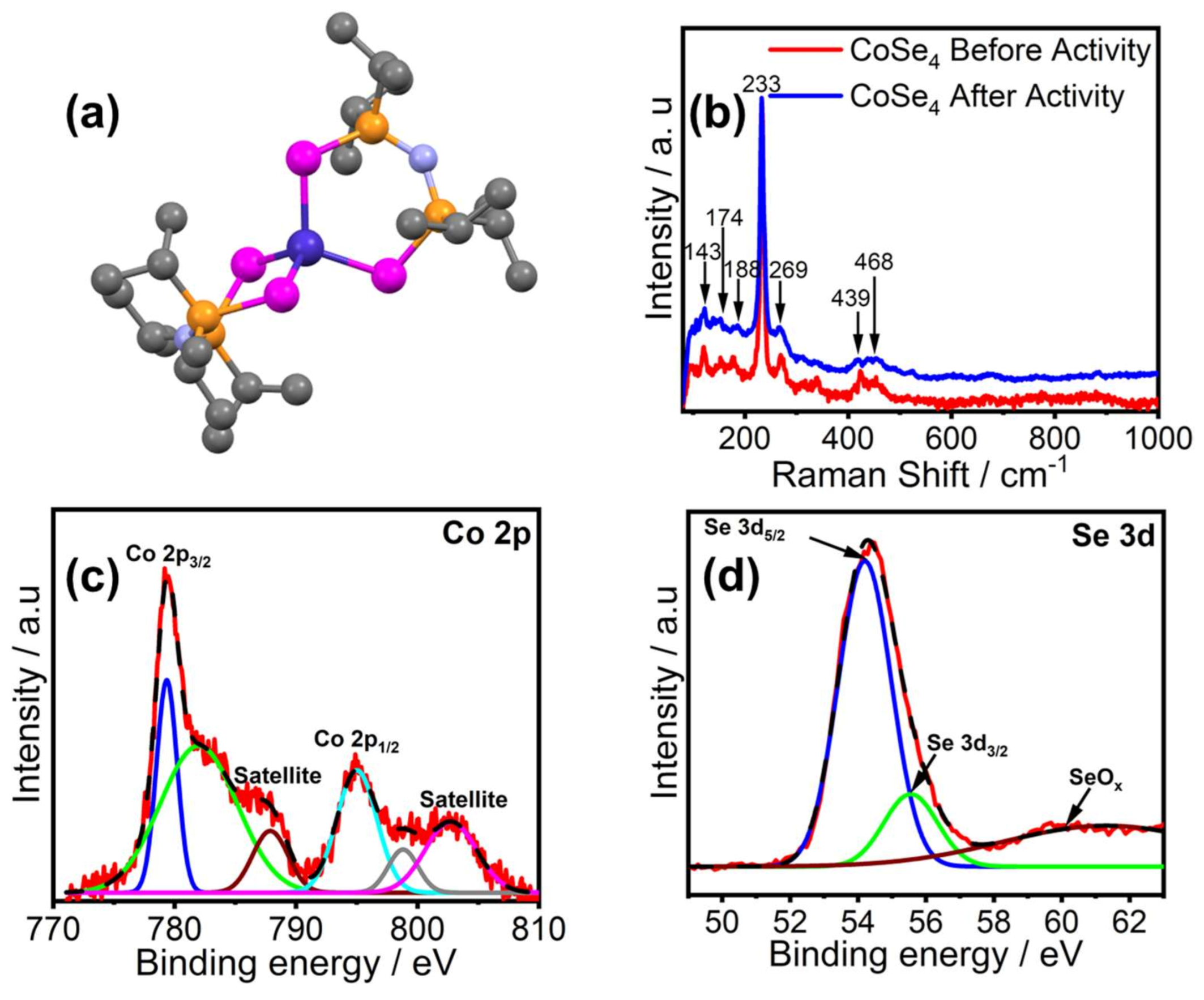
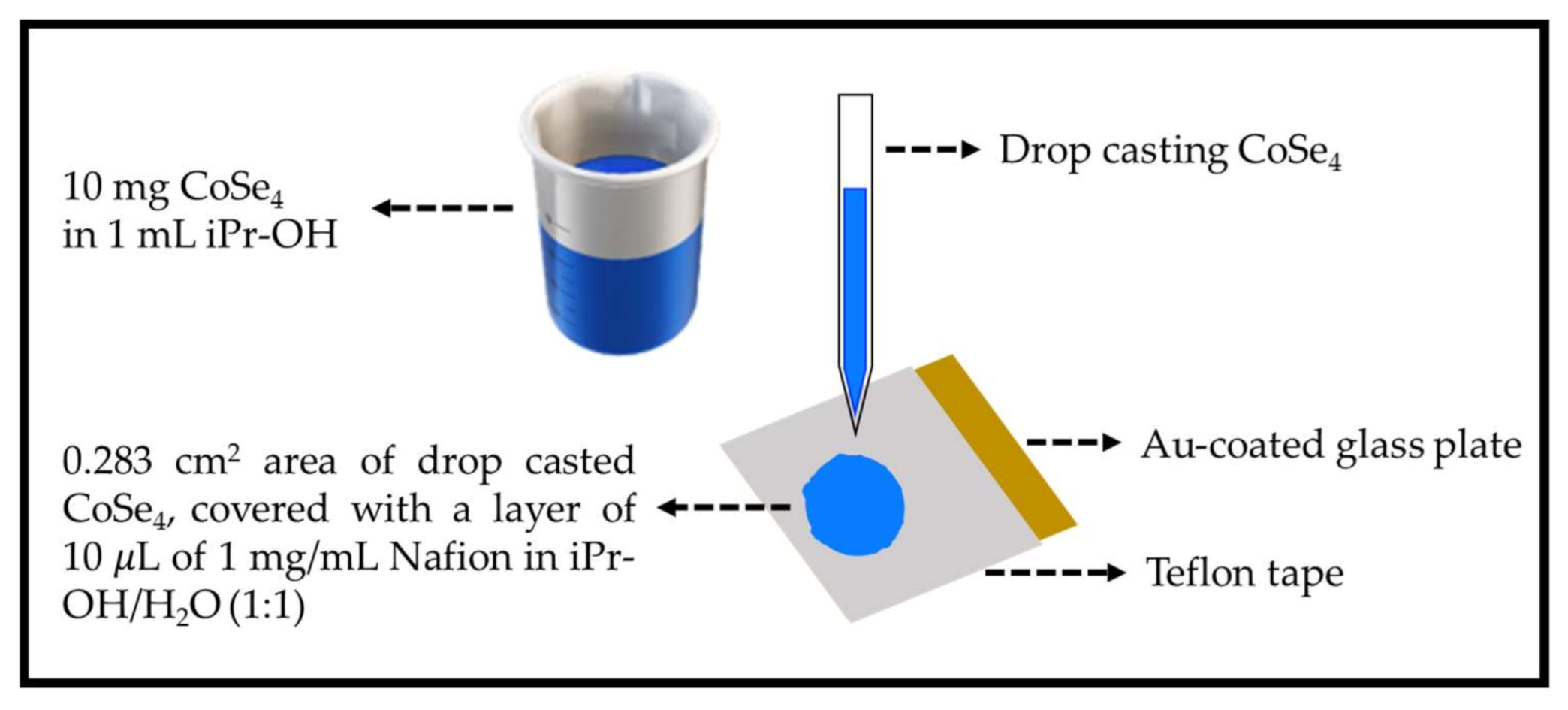
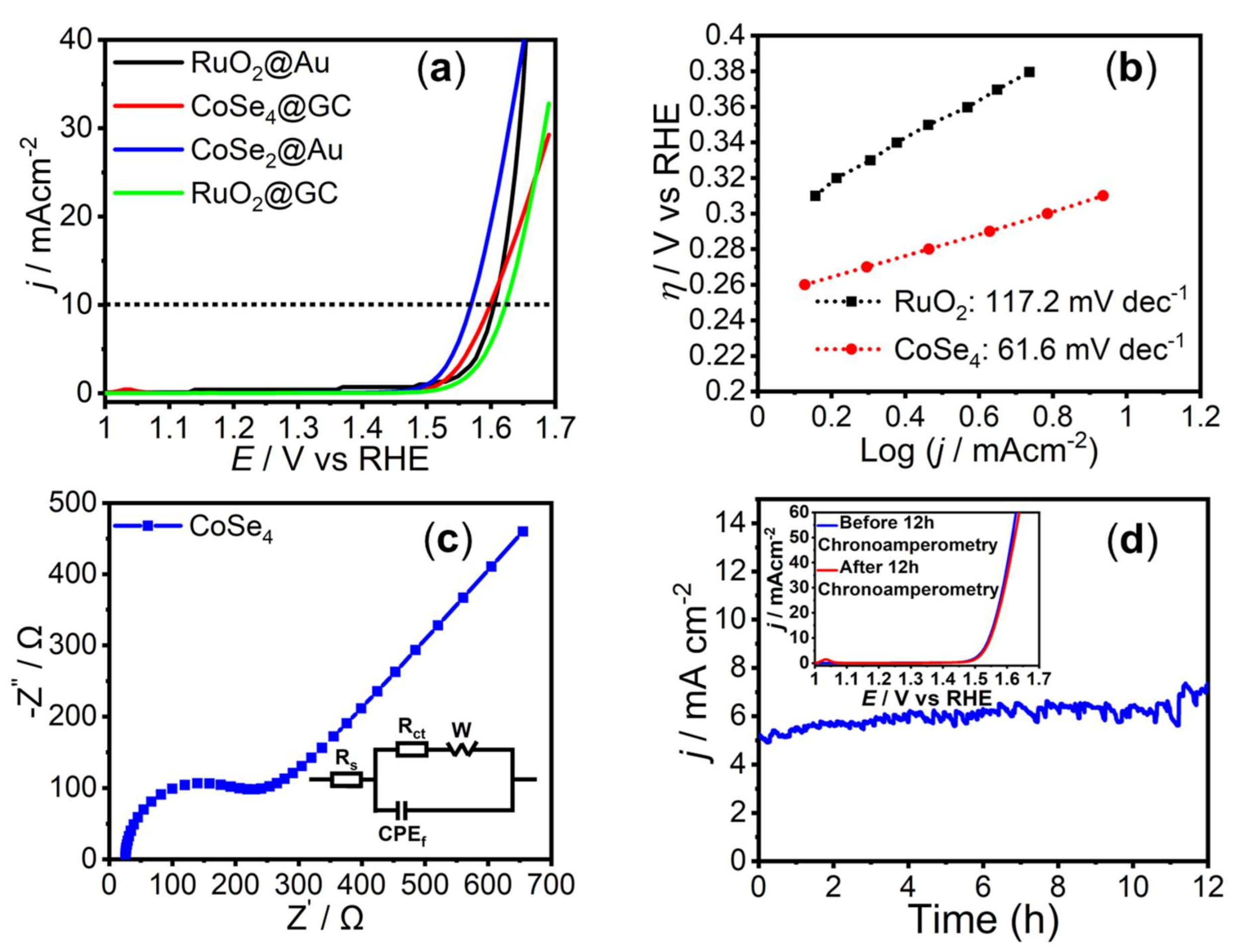
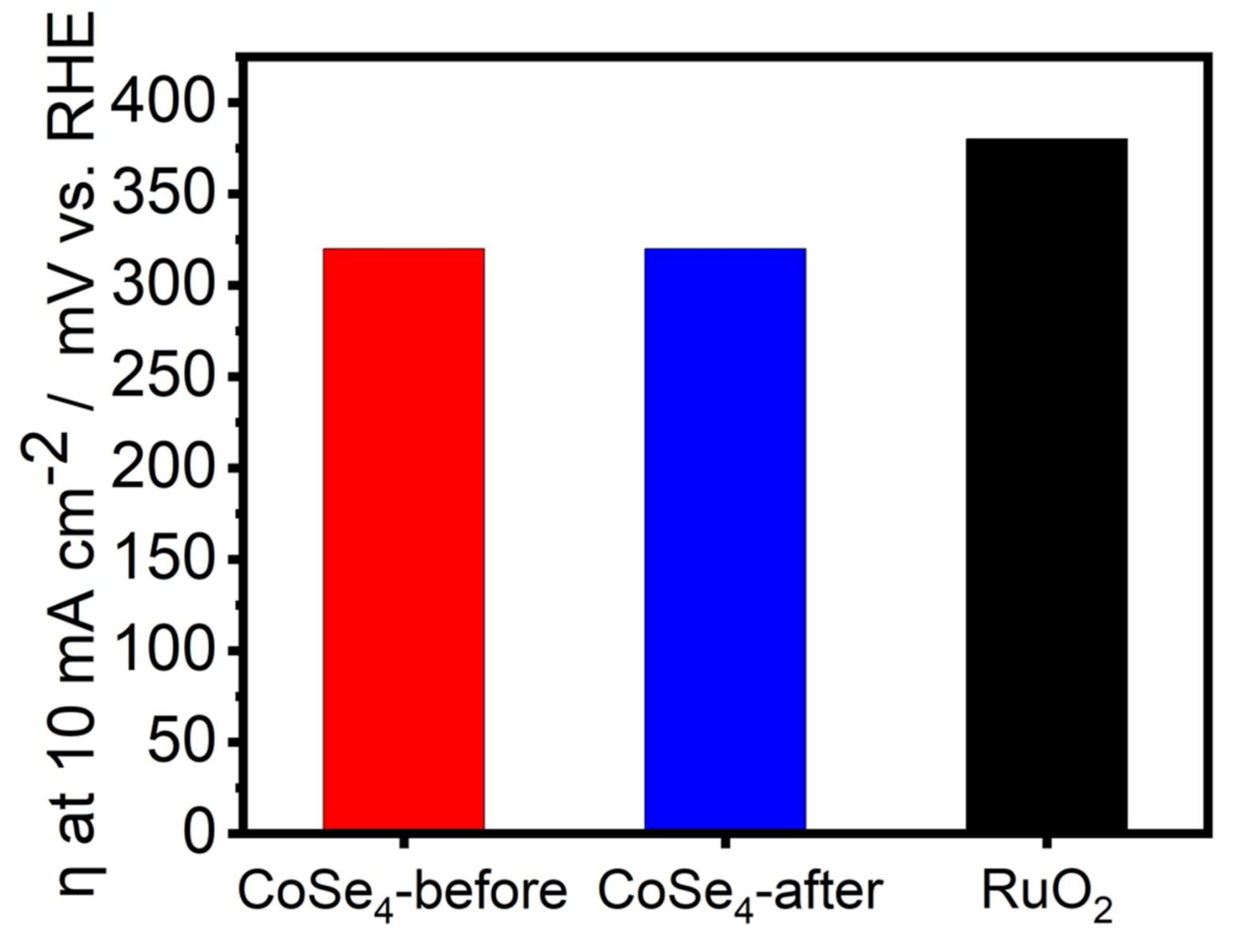
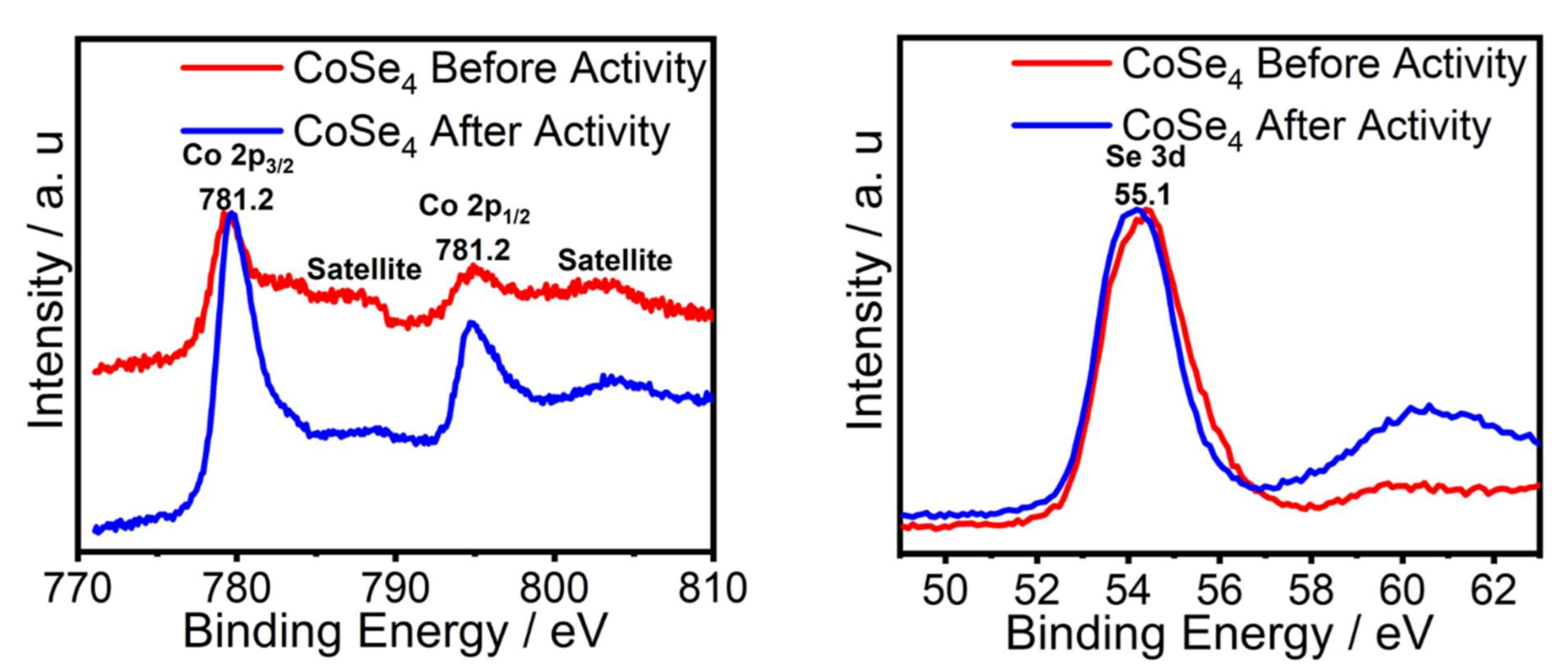
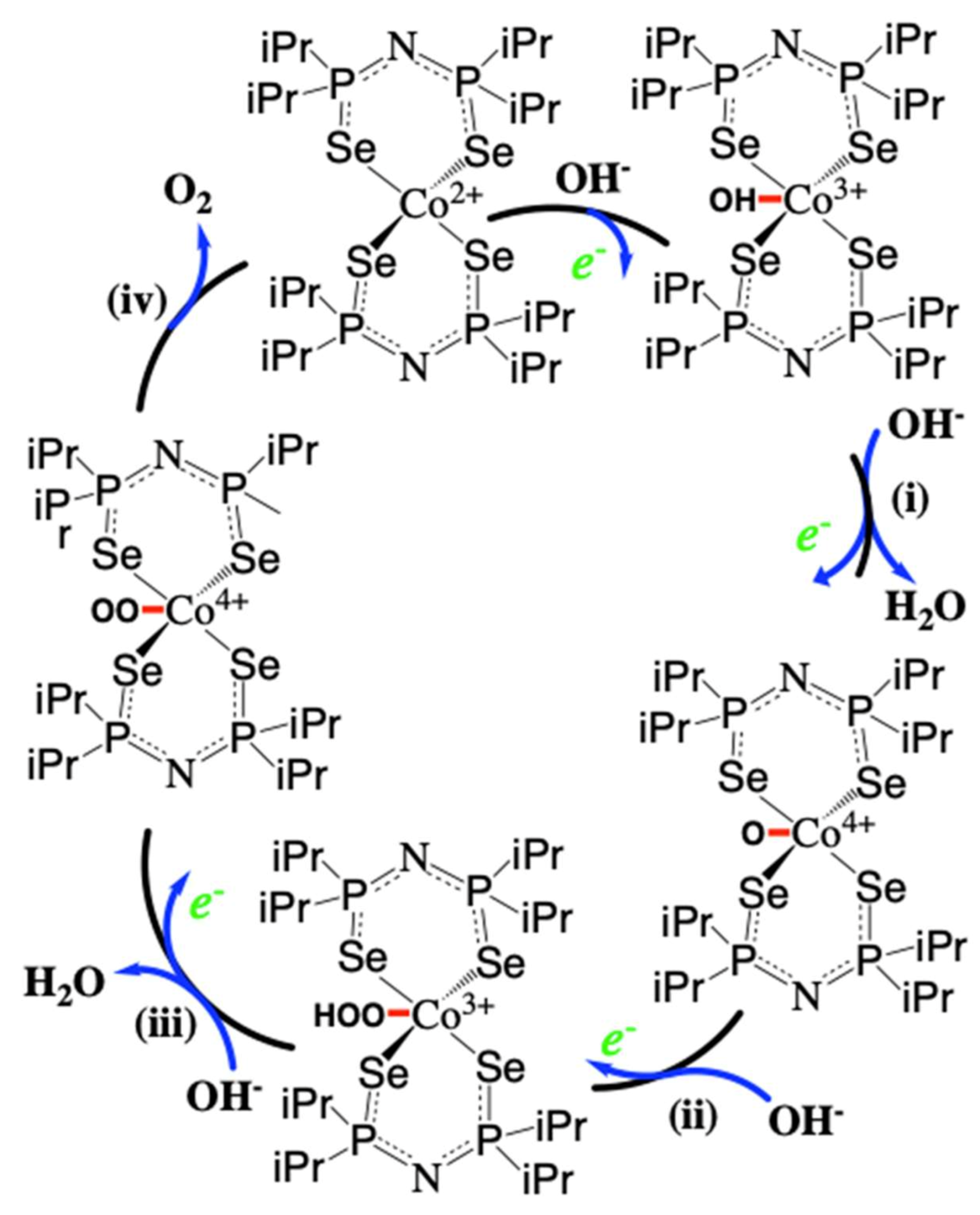
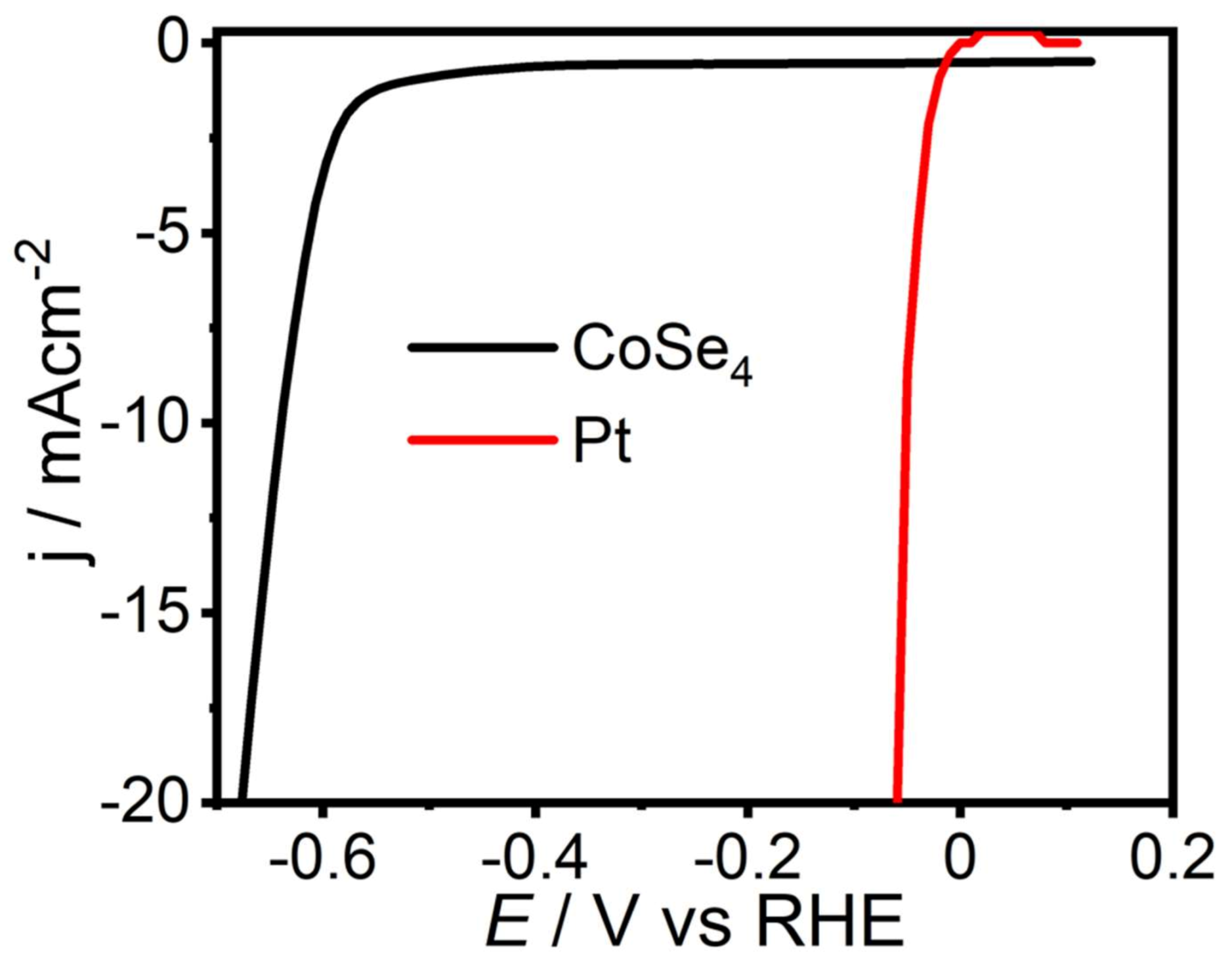
| OER | HER | ||||||
|---|---|---|---|---|---|---|---|
| Catalyst | Onset Potential (V) 1 | η to 10 mA cm−2 (V) 1 | Tafel Slope (mV dec−1) | Mass Activity at 320 mV (A g−1) | TOF at 320 mV (s−1) | Onset Potential (V) 1 | η to 10 mA cm−2 (V) 1 |
| CoSe4@Au | 1.44 | 0.32 | 61.6 | 14.15 | 0.032 | 0.52 | 0.63 |
| RuO2@Au 2 | 1.51 | 0.38 | 117.2 | - | - | - | - |
| Pt | - | - | - | - | - | 0.00 | 0.05 |
Publisher’s Note: MDPI stays neutral with regard to jurisdictional claims in published maps and institutional affiliations. |
© 2021 by the authors. Licensee MDPI, Basel, Switzerland. This article is an open access article distributed under the terms and conditions of the Creative Commons Attribution (CC BY) license (http://creativecommons.org/licenses/by/4.0/).
Share and Cite
Abdullahi, I.M.; Masud, J.; Ioannou, P.-C.; Ferentinos, E.; Kyritsis, P.; Nath, M. A Molecular Tetrahedral Cobalt–Seleno-Based Complex as an Efficient Electrocatalyst for Water Splitting. Molecules 2021, 26, 945. https://doi.org/10.3390/molecules26040945
Abdullahi IM, Masud J, Ioannou P-C, Ferentinos E, Kyritsis P, Nath M. A Molecular Tetrahedral Cobalt–Seleno-Based Complex as an Efficient Electrocatalyst for Water Splitting. Molecules. 2021; 26(4):945. https://doi.org/10.3390/molecules26040945
Chicago/Turabian StyleAbdullahi, Ibrahim Munkaila, Jahangir Masud, Polydoros-Chrisovalantis Ioannou, Eleftherios Ferentinos, Panayotis Kyritsis, and Manashi Nath. 2021. "A Molecular Tetrahedral Cobalt–Seleno-Based Complex as an Efficient Electrocatalyst for Water Splitting" Molecules 26, no. 4: 945. https://doi.org/10.3390/molecules26040945
APA StyleAbdullahi, I. M., Masud, J., Ioannou, P.-C., Ferentinos, E., Kyritsis, P., & Nath, M. (2021). A Molecular Tetrahedral Cobalt–Seleno-Based Complex as an Efficient Electrocatalyst for Water Splitting. Molecules, 26(4), 945. https://doi.org/10.3390/molecules26040945








